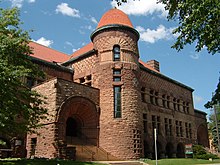The University of Minnesota system is a public university system with five campuses spread across the U.S. state of Minnesota.

The University of Minnesota is a public land-grant research university in the Twin Cities of Minneapolis and Saint Paul, Minnesota, United States. The Twin Cities campus comprises locations in Minneapolis and Falcon Heights, a suburb of St. Paul, approximately 3 mi (4.8 km) apart.

Williams Arena is an indoor arena located in Minneapolis, Minnesota. It is the home arena for the University of Minnesota's men's and women's basketball teams. It also housed the men's hockey team until 1993, when it moved into its own building, 3M Arena at Mariucci. The building is popularly known as The Barn, and its student section is known as "The Barnyard".

Pillsbury Baptist Bible College was an independent Baptist college in Owatonna, Minnesota, United States (1957–2008). Pillsbury described itself as a "biblical arts college." It offered a four-year program leading to the degrees of Bachelor of Arts in Bible and Bachelor of Science in Bible, as well as several associate degrees and a Bible certificate program.

The University of Minnesota Morris (UMN–Morris) is a public liberal arts college in Morris, Minnesota. It is part of the University of Minnesota system and was founded in 1960 as a public, co-educational, residential liberal arts college offering Bachelor of Arts degrees.

The University of Minnesota Law School is the law school of the University of Minnesota in Minneapolis, Minnesota. The school confers four law degrees: a Juris Doctor (J.D.), a Master of Laws (LL.M.), a Master of Science in Patent Law (M.S.P.L.), and a Doctor of Juridical Science (S.J.D.). The J.D. program offers a number of concentration opportunities, as well as dual and joint degree options with other graduate and professional schools of the university.

The University of Minnesota Crookston (UMN–Crookston) is a public college in Crookston, Minnesota. One of five campuses in the University of Minnesota system, UMN Crookston had a fall 2022 enrollment of 1,489 undergraduate students. Students come from 20 countries and 40 states.

The Pillsbury A-Mill is a former flour mill located on the east bank of the Mississippi River in Minneapolis, Minnesota. It was the world's largest flour mill for 40 years. Completed in 1881, it was owned by the Pillsbury Company and operated two of the most powerful direct-drive waterwheels ever built, each capable of generating 1,200 horsepower . In 1901 one of the turbines was replaced with a 2,500 horsepower one. Both the mill and its headrace tunnel are contributing resources to the St. Anthony Falls Historic District, which is on the National Register of Historic Places. The mill is also independently on the NRHP. The mill was named a National Historic Landmark in 1966 and has since been converted into the A-Mill Artist Lofts.

Coffman Memorial Union is a student union on the East Bank campus of the University of Minnesota in Minneapolis. Situated near the Mississippi River, Coffman anchors the south end of Northrop Mall, a grassy area at the center of campus that is bordered by the University's physics, mathematics, chemistry, and administration buildings, plus Walter Library and Northrop Auditorium. Coffman sits at the south end of the mall, across Washington Avenue, and opposite Northrop.
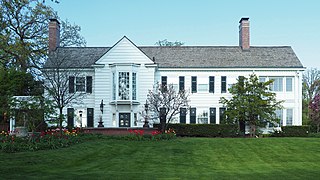
Eastcliff is a 20-room house overlooking the Mississippi River in St. Paul, Minnesota, United States, which serves as the official residence of the president of the University of Minnesota system. It was first built in 1922 by local lumber magnate Edward Brooks Sr. and donated to the university by the Brooks family in 1958, beginning its service as the president's official residence in 1960 when O. Meredith Wilson took the position. In 2000, the home was added to the National Register of Historic Places.
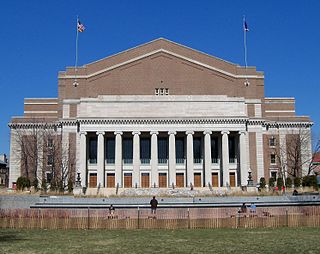
Cyrus Northrop Memorial Auditorium is a performing arts venue at the University of Minnesota in Minneapolis, Minnesota. It is named in honor of Cyrus Northrop, the university's second president. Various events are held within the building, including concerts, ballet performances, lectures, and graduations.

Clarence Howard Johnston Sr. was an American architect who practiced in the US state of Minnesota during the late 1800s and early 1900s. Specializing in domestic, religious, and public architecture, he served as Minnesota State Architect from 1901 to 1931. He is considered one of the most prolific architects in the state's history.

The Hubbard School of Journalism and Mass Communication is a journalism school at the University of Minnesota that offers programs in journalism, strategic communication and mass communication. It is located on the Minneapolis campus. It houses around 800 undergraduates and more than 30 graduate students in a given academic year.
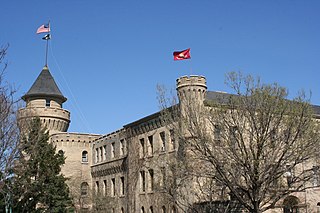
The University of Minnesota Armory is a building on the University of Minnesota campus in Minneapolis, Minnesota. The Armory was constructed in 1896 after the previous space for military training on the campus burnt in a fire in 1894. The facility served as the primary home for the Minnesota Golden Gophers men's basketball team as well as the University of Minnesota Marching Band after its construction. The basketball team moved to the Kenwood Armory in Downtown Minneapolis in 1925 while the band moved to the newly completed Music Education Building in 1922. Fielding H. Yost, Michigan Wolverines football coach, forgot the Little Brown Jug, one of the oldest college football traveling trophies, in the locker rooms of the Armory in 1903. The Armory was also the facility used for the University of Minnesota physical education department until 1935. The school's football team played some of their early games on the open field next to the Armory.

Harvey Ellis was an American architect, perspective renderer, painter and furniture designer. He worked in Rochester, New York; Utica, New York; St. Paul, Minnesota; Minneapolis, Minnesota; St. Joseph, Missouri; St. Louis, Missouri and Syracuse, New York.

LeRoy Sunderland Buffington (1847–1931) was an American architect from Minnesota who specialized in hotels, public and commercial buildings, churches, and residences. He was born September 22, 1847, in Cincinnati, Ohio. He studied architecture and engineering at the University of Cincinnati and graduated in 1869. He later moved to Saint Paul, becoming a partner of Abraham Radcliffe, and worked on the remodeling of the original Minnesota State Capitol. After the first capitol burned down, Buffington designed a replacement that served as the State House until 1904. In 1881 he claimed to have invented the method of building skyscrapers using load-bearing iron frames. He applied for a patent in November 1887 and received it in May 1888. Even though many subsequent builders used this method of construction, Buffington was mostly unsuccessful in collecting royalties from his patent. Buffington remained in private practice in Minneapolis until his death on February 15, 1931.
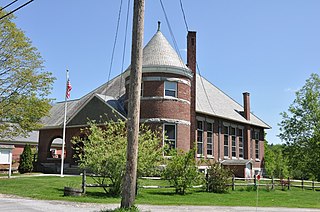
Pillsbury Memorial Hall, located at 93 Main Street, is the town hall of Sutton, New Hampshire. It was built in 1891, funded by a gift from New Hampshire native John Sargent Pillsbury, founder of the Pillsbury Company and a leading Minnesota politician. It is the only Romanesque style town hall building in Merrimack County. The building was listed on the National Register of Historic Places in 1993.
The University of Minnesota School of Nursing is the nursing school of the University of Minnesota that was founded in 1909. It is the nation's first and oldest continuously operated university-based school of nursing. It has historically been an innovator in nursing, it was the first university to create a Bachelor of Science in Nursing and it graduated the first bachelor's degree nurses in 1909. It is ranked amongst the nation's top nursing schools, it has a research budget of $6 million each year, and produces more than half of the faculty in Minnesota's public and private nursing schools and advanced practice nurses. College courses and continuing education are offered at the University of Minnesota East Bank in Minneapolis and at the University of Minnesota, Rochester campus in Rochester, Minnesota.

Charles Sumner Sedgwick was an American architect based in Minneapolis, Minnesota.

The Northrop Mall Historic District is a historic district located at the University of Minnesota's east bank campus in Minneapolis, Minnesota. It covers buildings along Northrop Mall and in the surrounding area. The district was found eligible to be listed on the National Register of Historic Places in 2006, and was officially added in January 2018. Most of the buildings are connected by the Gopher Way; a tunnel and skyway network providing easy and direct enclosed pedestrian access. The district is roughly bounded by Pillsbury Drive SE to the north, East River Parkway to the west, Union Street SE to the east, and Delaware Street SE to the south. It is located directly south of the university's Old Campus Historic District.





